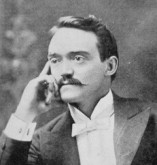Charles Francis Jenkins
 American inventor
American inventor
C. Francis Jenkins and Thomas Armat together invented one of the most effective motion picture projectors of their day, and presented projected films for paid admission in September 1895. Jenkins was raised on a farm near Richmond, Indiana and by 1890 the amateur inventor was working as a civil service stenographer in Washington D.C. His motion picture experiments had started as early as 1891, and from 1893, funded by one James P. Freeman, he employed an engineer to work on apparatus for ‘… the recording and reproduction of action’, possibly a rotary-lens camera and/or cabinet peepshow device.
By the summer of 1894, he apparently had some success with projecting moving images of very limited size. In 1895 he quit his job to pursue inventing full time. In October 1894 Jenkins met Thomas Armat at the Bliss School of Electricity, and on 25 March 1895 they made a formal agreement to work together. Armat wanted to use Jenkins’s cameras to supply films for his projection experiments; Jenkins wanted Armat to fund the projection developments. Soon abandoning experiments with continuously-moving film, they tried a mutilated-gear mechanism but it was quickly damaged by the stresses involved. Armat sketched out an idea for a piston arrangement to move the film, spurring Jenkins to revive an arrangement that he had tinkered with previously – the eccentric gear, or ‘beater’ movement, (similar to that patented in France in 1893 by Georges Demenÿ). This proved successful and in late September 1895, charging 25c admission, they projected Kinetoscope films to audiences at the Cotton States Exposition, Atlanta, in two small screening rooms served by a common projection booth. ‘Borrowing’ one of their three Phantoscopes (a name he used for most of his motion picture devices, leading to confusion for modern researchers), Jenkins departed in mid-October to give a projection demonstration at his birthplace, Richmond, and did not return. He filed a patent as sole inventor but this was ruled to be ‘in interference’ with a joint patent taken out previously, and eventually the case was decided in favour of the joint application.
On 18 December 1895 Jenkins demonstrated ‘his’ projector, to a distinguished audience at the Franklin Institute, Philadelphia, and was awarded a medal for progress in the field. After protestations by Armat most of the developments were recognised as joint efforts. Embittered by the dispute, Jenkins later falsely claimed successful film projection at Richmond on 6 June 1894 – more than a year before his documented demonstrations in that town. In the Spring of ’96, while Armat negotiated with Raff & Gammon for Edison to exploit their projector, Jenkins formed a short-lived agreement with the Columbia Phonograph Company, but eventually sold out the Phantascope rights to Armat; although he continued to exhibit with a version of his machine, claiming its superiority over the Vitascope. Jenkins went on to found the Society of Motion Picture Engineers (now SMPTE). In 1925, neck-and-neck with British pioneer John Logie Baird, he demonstrated mechanical television. By the late 1920s he had become a prominent figure in American television development, with novel transmission equipment involving prismatic glass scanning discs. Backed by the De Forest Radio Company, he operated experimental television stations in Washington D.C. and New York City, and by 1931 was selling receivers for the home. Jenkins eventually held more than 400 patents in such diverse areas as paper containers, automobiles, and radio aerials for aeroplanes.
Who’s Who of Victorian Cinema